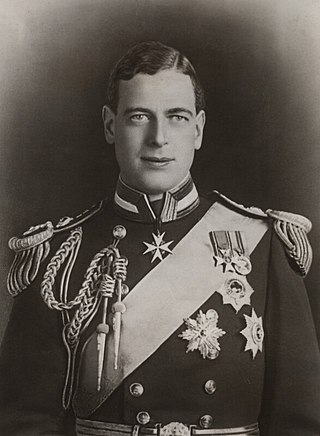
Prince George, Duke of Kent was a member of the British royal family, the fourth son of King George V and Queen Mary. He was a younger brother of kings Edward VIII and George VI. Prince George served in the Royal Navy in the 1920s and then briefly as a civil servant. He became Duke of Kent in 1934. In the late 1930s he served as an RAF officer, initially as a staff officer at RAF Training Command and then, from July 1941, as a staff officer in the Welfare Section of the RAF Inspector General's Staff. He was killed in the Dunbeath air crash on 25 August 1942.

An aide-de-camp is a personal assistant or secretary to a person of high rank, usually a senior military, police or government officer, or to a member of a royal family or a head of state.
Air commodore is a air officer rank used by some air forces, with origins from the Royal Air Force. The rank is also used by the air forces of many countries which have historical British influence and it is sometimes used as the English translation of an equivalent rank in countries which have a non-English air force-specific rank structure.
Colonel-in-chief is a ceremonial position in a military regiment. It is in common use in several Commonwealth armies, where it is held by the regiment's patron, usually a member of the royal family.
An equerry is an officer of honour. Historically, it was a senior attendant with responsibilities for the horses of a person of rank. In contemporary use, it is a personal attendant, usually upon a sovereign, a member of a royal family, or a national representative. The role is equivalent to an aide-de-camp, but the term is now prevalent only among some members of the Commonwealth of Nations.
A flag officer is a commissioned officer in a nation's armed forces senior enough to be entitled to fly a flag to mark the position from which the officer exercises command.
Colonel is a Canadian Forces rank used by commissioned officers who wear the army, air force or special operations uniform. Captain(N) is the equivalent rank for officers who wear the navy uniform. A colonel is senior to the army and air force rank of lieutenant-colonel or the naval rank of commander, and junior to the army and air force rank of brigadier-general or the naval rank of commodore.
The officer ranks of the Royal Air Force, as they are today, were introduced in 1919. Prior to that Army ranks were used.

These are the official Royal Navy Officer ranks ordered by rank. These ranks are now part of the NATO/United Kingdom ranks, including modern and past.

This is a list of Royal Navy ratings rank insignia.
The relationship between the Canadian Crown and the Canadian Armed Forces is both constitutional and ceremonial, with the king of Canada being the commander-in-chief of the Canadian Forces and he and other members of the Canadian royal family holding honorary positions in various branches and regiments, embodying the historical relationship of the Crown with its armed forces. This construct stems from Canada's system of constitutional monarchy and through its 500 years of monarchical history, the relationship symbolically represented through royal symbols, such as crowns on military badges and insignia, coats of arms, royal portraits, and the grant of the royal prefix to various military units and institutions. The role of the Canadian sovereign within the Canadian Armed Forces is established within the Canadian constitution, the National Defence Act, and the King's Regulations and Orders (KR&Os) for the Canadian Forces.

Captain (Capt) is a senior officer rank of the Royal Navy. It ranks above commander and below commodore and has a NATO ranking code of OF-5. The rank is equivalent to a colonel in the British Army and Royal Marines, and to a group captain in the Royal Air Force. There are similarly named equivalent ranks in the navies of many other countries.
Royal Colonel is an appointment made by the British monarch, currently King Charles III, to members of the British Royal Family who are appointed to the position of Colonel-in-Chief or Colonel of a regiment within the British or Commonwealth army. Royal Colonel appointments are made for regiments and military units of the British Army. Similar roles exist in honorary Air Commodores-in-Chief and Air Commodores for the Royal Air Force, and honorary Commodore-in-Chief for the Royal Navy.
Many members of the British Royal Family have seen service in British or other Commonwealth armed forces, and others hold honorary ranks or positions. This is a list detailing formal military service by members of the British royal family.
Air Commodore-in-Chief is a senior honorary air force appointment which originated in the Royal Air Force and now exists in the air forces of various Commonwealth realms. Appointees are made Air Commodore-in-Chief of a large air force organisation or formation. Initially only the British monarch held air commodore-in-chief appointments. However, since the second half of the 20th century, other members of the royal family have been appointed to such positions in the United Kingdom and the other realms such as Australia, Canada and New Zealand. As of 2020, these appointments have been given to just six senior members of the royal family, of whom four were reigning or future monarchs of the Commonwealth realms.




